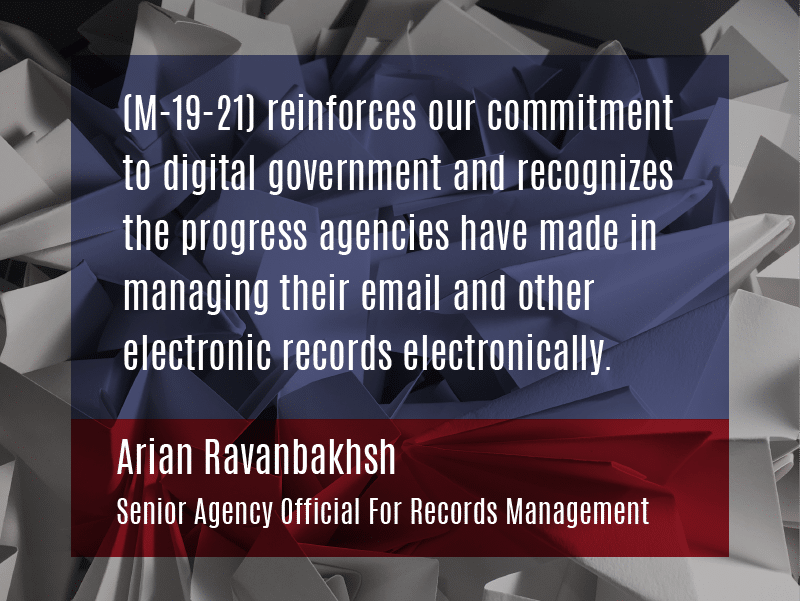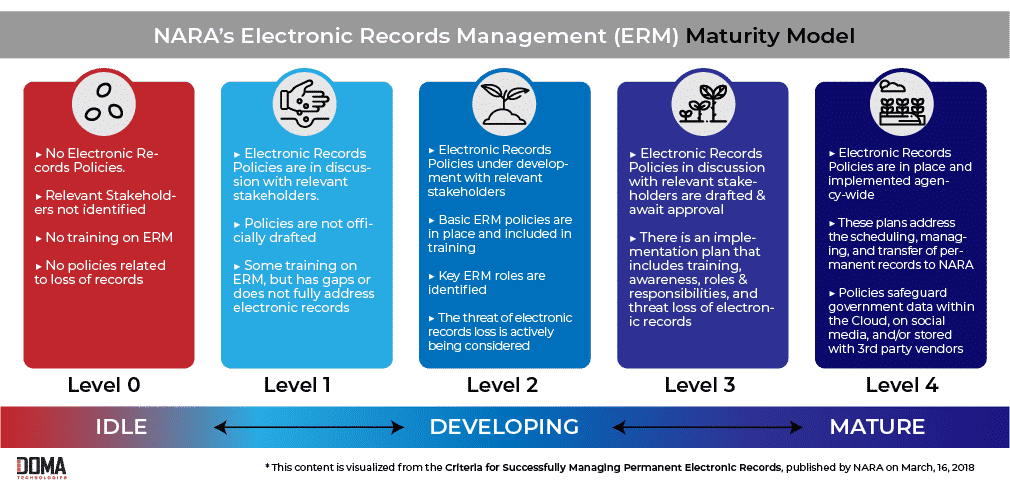Developing an Electronic Records Management Strategy in Line with NARA's M-19-21 Mandate
How M-19-21 has Expanded M-12-18 and Changes the Way Government sees Record Management
March 10, 2020
The Story Behind NARA
Paper record-keeping has fueled the United States Federal Government since its inception. Since its founding, the United States Government has been using paper to communicate, develop and define policy, and to document key historical events. Since 1934 The National Archives and Records Administration (NARA) has been charged with the protection and oversight of the Federal Government’s vast stores of historically significant records. Documents of significance ranging from the Declaration of Independence and Bill of Rights to immigration and naturalization records that span generations fall under their care. You can imagine the logistical challenge that comes with protecting and storing over 241 years of history.
“NARA keeps only those Federal records that are judged to have continuing value—about 2 to 5 percent of those generated in any given year. By now, they add up to a formidable number, diverse in form as well as in content. There are approximately 10 billion pages of textual records; 12 million maps, charts, and architectural and engineering drawings; 25 million still photographs and graphics; 24 million aerial photographs; 300,000 reels of motion picture film; 400,000 video and sound recordings; and 133 terabytes of electronic data. All of these materials are preserved because they are important to the workings of Government, have long-term research worth, or provide information of value to citizens.”
Managing this massive archive has posed considerable challenges – not least of which is space. In light of this, The Federal Government now recognizes that paper records can be a hindrance to agility and efficiency, particularly with the exponential growth of content year over year. In response, NARA has implemented the M-10-21 mandate to help the Federal Government transition to electronic record keeping.
What is M-19-21?
M-19-21 is a new directive that was issued on June 28, 2019, that consolidated and added more requirements to the previous M-12-18 directive. The purpose of this directive is to help the government transition to electronic records with the purpose of increasing efficiency, accuracy, and economical use of space. The deadline for digitally managing all permanent records has already passed – meaning many agencies have already fallen behind. Ultimately, this initiative is designed to transition agencies into managing government records, whether temporary or permanent, entirely within an electronic environment by 2022.
The key points of M-19-21 are:
- ALL Federal Records (not only Permanent Electronic Records as stated in M-12-18, but also Temporary Records) must be created, managed, and maintained in electronic format by 2022
- Agencies need to close their own facilities and transfer any paper records to a Federal Records Center or a Commercial Storage Facility by 2022.
- Agencies must designate a Senior Agency Official for Records Management and Agency Records Officer.
- Agencies must maintain compliance with their records management including personnel training, scheduling records, workflow scheduling, etc.

Who needs to be M-19-21 Compliant?
M-19-21 is a directive set forth by the National Archives and Records Administration (NARA) and the Office of Management and Budget (OMB) with record management requirements for Federal Agencies.
NARA’s M-19-21 is a government-wide initiative and applies to all federal agencies. To learn more about the requirements of M-19-21 and see FAQ’s about the specifics of the directive, visit our NARA Compliance page by clicking below:
How do Federal Agencies Develop an Effective Plan?
With the deadline for full compliance looming, getting compliant is quickly becoming a priority for many federal agencies. According to NARA’s Criteria for Successfully Managing Permanent Electronic Records there are four primary concerns when developing an effective Electronic Records Management (ERM) strategy:
Policies
- Relevant stakeholders should be identified and guide the policy development process
- Training should be implemented to standardize document handling at your agency
- Policies should be clear, enforceable, and aligned with long term record’s management goals
Systems
- Implement systems that can create, capture, manage, preserve, and transfer in electronic formats
- Automation can be a powerful tool in ensuring records are transferred to NARA with all required meta data
- Systems should carefully consider the document life cycle for your agency – some records are ephemeral while others may need to be retained and referenced for decades
Records Access
- Access to records improves you agency’s ability to make quick decisions
- Records should be protected from unauthorized access, alteration, deletion, or loss
- Effective electronic records access can make documents searchable, saving time and effort
Disposition
- As your agency transitions, the need to convert documents into acceptable formats and tag them correctly is more important than ever because:
- By 2022, NARA will no longer accept transfers of permanent or temporary records in analog formats and will accept records only in electronic format and with appropriate metadata
- Beginning January I, 2023, all other legal transfers of permanent records must be in electronic format, to the fullest extent possible, regardless of whether the records were originally created in electronic formats
How Does my Agency get Started?
The first step to compliance is finding out where you stand. NARA’s Electronic Records Management (ERM) Maturity Model gives you the basics for self-assessment. See the info graphic below to see where you agency stand on the road to maturity. From there you can determine next steps.
For many, the first step is identifying any permanent records still haven’t been digitized in accordance with M-19-21 along with all other analog records that still need to be digitized. Once you have identified those records have your agency’s Records Officer develop a plan to be compliant by December 31, 2022.

How does DOMA help agencies accomplish M-19-21 compliance?
If you are struggling to with next steps in your electronic records management strategy it can be difficult to pinpoint next steps. DOMA Technologies has considerable experience working with the federal government and is ready to assist you on your journey to become M-19-21 compliant. As a GSA schedule contractor that focuses on records management we have help you with records conversion, meta data tagging, secure destruction, and more.
DOMA’s secret cleared facilities operate highly secure chain of custody protocols for physical records and our electronic security meets NIST, HIPAA, SAS70, DoD, and other Federal Guidelines. Federal records are safe at every stage of the DOMA digital transition process. A secure chain of custody beings at pickup with our GPS tracked vehicles and follows through until the ultimate delivery of your digitized records. After digitization, DOMA will securely destroy records or return the records to your location, commercial storage, or a Federal Records Center. You receive your digital records on a secure flash drive, via a trusted method of electronic delivery, or you can retrieve them from DOMA’s secure Cloud ECM for real-time access.
Read more about how we help you build an effective, M-19-21 compliant ERM with our data and document management solutions:
About DOMA- Powered by Tech, Driven by People
DOMA Technologies (DOMA) is a software development and digital transformation company whose mission is to change customer lives by lightening their workload through faster and more targeted access to their data. Since 2000, our team of 200+ experts has helped businesses navigate all aspects of the digital world. We are a dedicated strategic partner for the federal government and private sector clients at every stage of their unique digital transformation journey.

Author:
Danielle Wethington
Director of Communications
DMT@DOMAonline.com
NARA Compliance

Learn more about DOMA initiatives that can get you compliant with M-19-21.
Recent News
Learn More about DOMA’s Services:
Digital Solutions | Cloud Solutions | Hyper Automation | DX Software | Healthcare | Federal Government | SLED | Commercial



